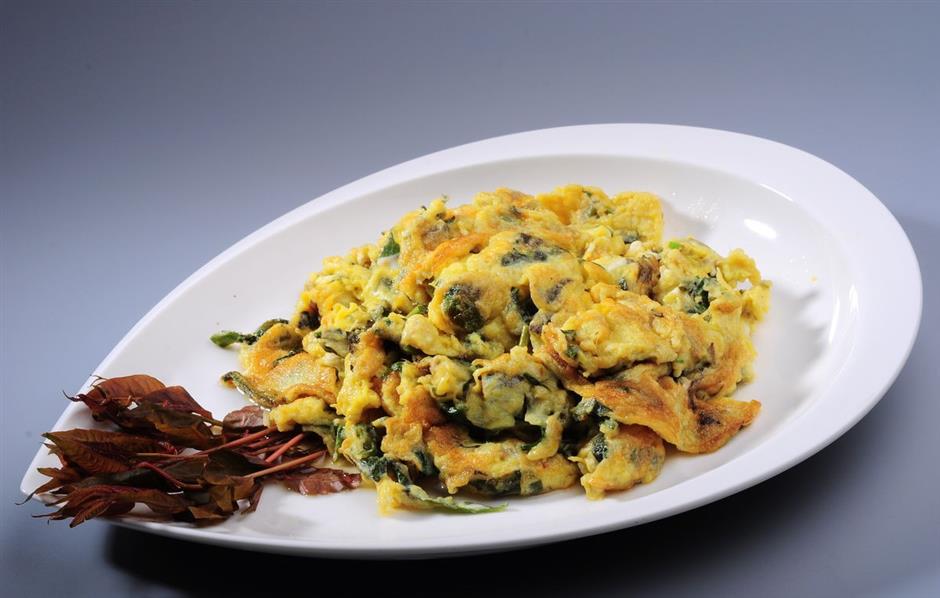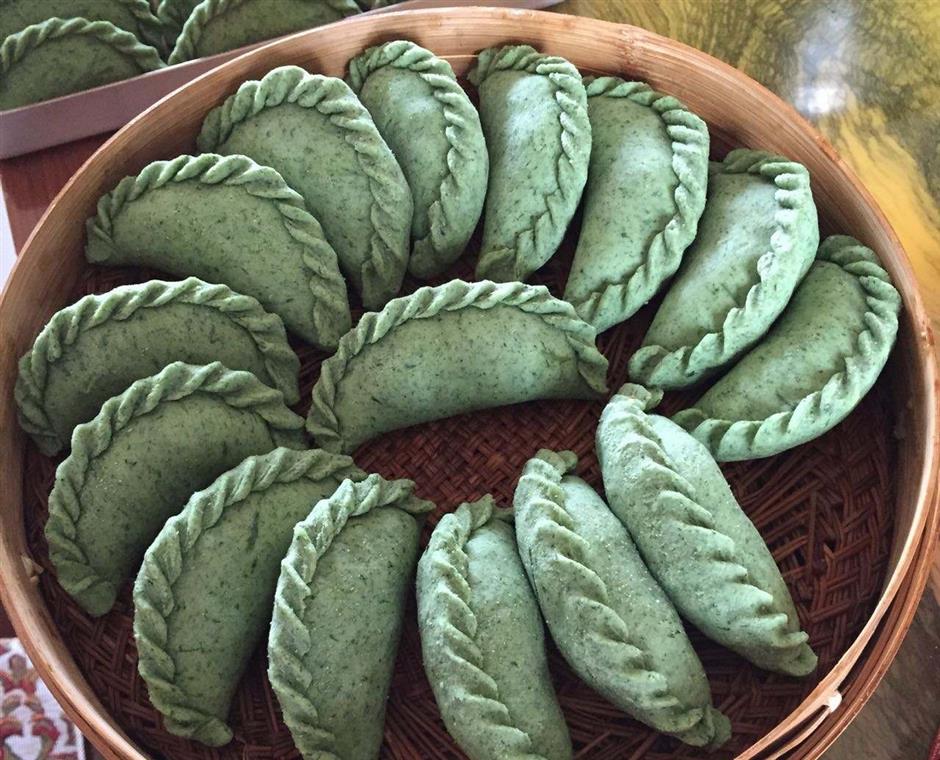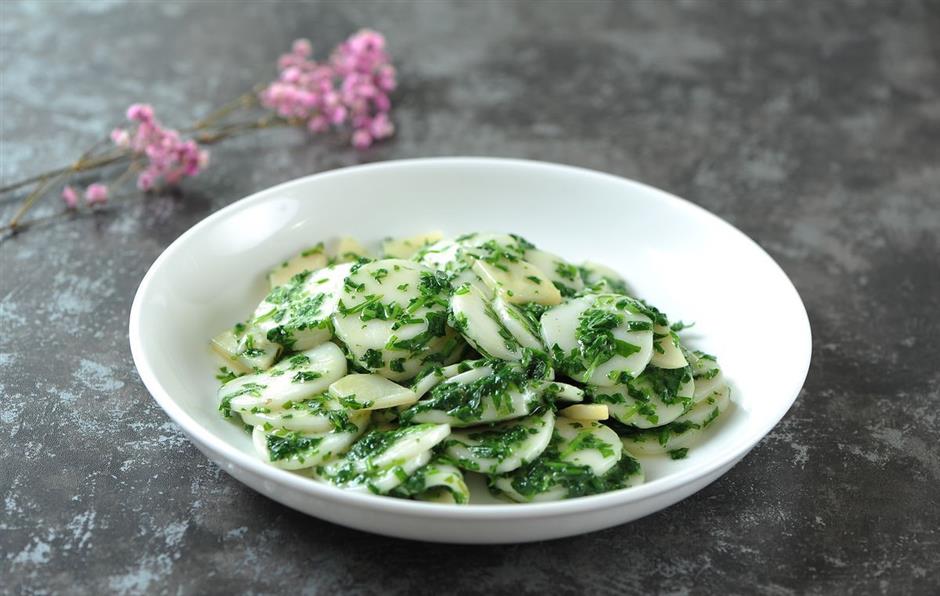Nature's garden serving up wild aromatic herbs in spring
Spring is a good time to try aromatic herbs that have grown in the wild. The Chinese have a long history of using herbs in both a culinary nature or for medical therapy. Shanghai Daily has been out and about checking some of the most common edible herbs in Hangzhou and its surrounding areas.

Black glutinous rice snacks at Jingning She Autonomous Prefecture
Sea bilberry 乌稔
As the only ethnic minority group in Zhejiang Province, She people live in the south mountainous areas. The Jingning She Autonomous Prefecture in Lishui City is the first and only autonomous county for She people across the country.
They are well known for eating black glutinous rice around the time of Shangsi Festival, which falls on the third day of the third month of the Chinese lunar calendar. The black color comes from the sea bilberry leaves, an evergreen shrub from the heath family, which also includes cranberry, blueberry and huckleberry.
The tradition is said to be related to a She general in the 7th century when he asked his soldiers to collect fruits of sea bilberry, which was the only food available, and led his people to a victory in the end.
To make such a tasty snack, one has to crush the leaves in a stone mortar. Boil the crushed leaves in a sealed filter bag for several minutes so the remaining juice is used to stain the rice while cooking.
Two flavors are usually offered. The sweet one is wrapped in reed leaves and topped with sugar. She people also steam them in bamboo tubes with preserved pork and seasonal vegetables like peas and broad beans.

Chinese toon with scrambled eggs, paired with fresh purple toon leaves
Chinese toon 香椿
The Chinese toon is another leafy vegetable that has been kept long in the memories of many Southerners’ spring. It has a strong onion-like flavor and people claim it is tastier than meat.
Judging from the colors of its leaves, there are two types of toon, a purple one and a green one. The plants with purple leaves are considered to have a nicer flavor than the green herb.
The fresh toon leaves contain certain quantities of nitrate and nitrite. Only the young leaves can be used and boiled in water before use.
The baby leaves are highly nutritious and used to be an article of tribute, together with lychee, to the court as early as the Han Dynasty (206 BC-AD 220).
Simple yet delicious recipes include scrambled eggs with toon, bean curd topped with toon and cold noodles mixed with toon and soy sauce.
In some parts of China, people also use it to make hot chili sauce, which may be served with rice, dumplings or other staple parts.

Dumplings made with mugwort leaves
Chinese mugwort 艾草
Mugwort is first and foremost a healing herb in China, although it is edible as well. During the Dragon Boat Festival, which falls on the fifth day of the fifth month of the Chinese lunar calendar, people will hang branches of mugwort on doorways to ward off insects as well as the evil spirits.
It is also widely used in a traditional Chinese medicine therapy called moxibustion. Practitioners burn a cigar-like mugwort stick and fumigate above a certain area of a patient’s skin. Chinese people believe it can activate blood circulation and expel excessive moisture in the body.
The confectionary takes many shapes, from pies, dumplings to buns. The name also varies. But the production process is more or less the same.
The fresh leaves are boiled with alkaline water to get rid of their bitterness. They are then kneaded into glutinous rice dough that has been cooked in a steamer beforehand. The fillings can range from red beans to sesame paste, or minced pork mixed with preserved mustard and bamboo shoots.

Shepherd’s purse stir-fried with rice cakes
Shepherd’s purse 荠菜
In the Jiangnan region (south of the lower reaches of the Yangtze River), the aroma of a shepherd’s purse herb represents the taste of spring for many.
The shape of its fruit resembles the purses Europeans once hung from their belts, and gave rise to the herb’s name. The plant is commonly seen on mountain slopes, in rice fields and on street corners.
The Northern Song Dynasty (960-1127) poet and politician Su Shi hailed the plant as “extremely delicious.” He insisted that the taste even outshined that of the “eight treasures from sea and flatland.”
The Dongpo soup, invented by Su, is made by cooking chopped shepherd’s purse with rice, oil and ginger. The refreshing sweet taste of the herb was so impressive that Su wrote about it several times in his poems and letters to his friends and family.
It is also used in fillings for wonton, baozi (steamed bun with filling) and spring rolls, where it is mixed with minced pork, dried bean curd and sometimes mushrooms. And shepherd’s purse stir-fried with rice cakes and bamboo shoots is a popular delicacy in many parts of Zhejiang Province, including Hangzhou, Ningbo and Shaoxing.
















